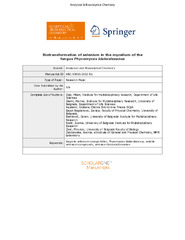Prikaz osnovnih podataka o dokumentu
Biotransformation of selenium in the mycelium of the fungus Phycomyces blakesleeanus
| dc.creator | Žižić, Milan | |
| dc.creator | Stanić, Marina | |
| dc.creator | AQUILANTI, Giuliana | |
| dc.creator | Bajuk-Bogdanovic, Danica | |
| dc.creator | Branković, Goran | |
| dc.creator | Rodić, Ivanka | |
| dc.creator | Živić, Miroslav | |
| dc.creator | Zakrzewska, Joanna | |
| dc.date.accessioned | 2023-09-15T07:40:35Z | |
| dc.date.available | 2023-06-27 | |
| dc.date.issued | 2022 | |
| dc.identifier.issn | 1618-2642 | |
| dc.identifier.uri | http://rimsi.imsi.bg.ac.rs/handle/123456789/2106 | |
| dc.description.abstract | Biotransformation of toxic selenium ions to non-toxic species has been mainly focused on biofortifcation of microorganisms and production of selenium nanoparticles (SeNPs), while far less attention is paid to the mechanisms of transformation. In this study, we applied a combination of analytical techniques with the aim of characterizing the SeNPs themselves as well as monitoring the course of selenium transformation in the mycelium of the fungus Phycomyces blakesleeanus. Red coloration and pungent odor that appeared after only a few hours of incubation with 10 mM Se+4 indicate the formation of SeNPs and volatile methylated selenium compounds. SEM–EDS confrmed pure selenium NPs with an average diameter of 57 nm, which indicates potentially very good medical, optical, and photoelectric characteristics. XANES of mycelium revealed concentration-dependent mechanisms of reduction, where 0.5 mM Se+4 led to the predominant formation of Se–S containing organic molecules, while 10 mM Se+4 induced production of biomethylated selenide (Se−2) in the form of volatile dimethylselenide (DMSe) and selenium nanoparticles (SeNPs), with the SeNPs/DMSe ratio rising with incubation time. Several structural forms of elemental selenium, predominantly monoclinic Se8 chains, together with trigonal Se polymer chain, Se8 and Se6 ring structures, were detected by Raman spectroscopy | sr |
| dc.language.iso | en | sr |
| dc.publisher | Springer-Verlag GmbH Berlin Heidelberg | sr |
| dc.relation | info:eu-repo/grantAgreement/MESTD/inst-2020/200053/RS// | sr |
| dc.relation | info:eu-repo/grantAgreement/MESTD/inst-2020/200051/RS// | sr |
| dc.relation | "info:eu-repo/grantAgreement/MESTD/inst-2020/200178/RS// | sr |
| dc.rights | openAccess | sr |
| dc.source | Analytical and Bianalytical Chemistry | sr |
| dc.subject | Biogenic selenium nanoparticles · | sr |
| dc.subject | Phycomyces blakesleeanus · | sr |
| dc.subject | Volatile selenium compounds | sr |
| dc.subject | Selenium biotransformation | sr |
| dc.title | Biotransformation of selenium in the mycelium of the fungus Phycomyces blakesleeanus | sr |
| dc.type | article | sr |
| dc.rights.license | ARR | sr |
| dc.rights.holder | Co-owner Consortium consisting of GDCh, SFC, SEQA, RSEQ, DAS/SCS, ASAC, SCI, PTC and Springer-Verlag GmbH Berlin Heidelberg | sr |
| dc.citation.epage | 6222. | |
| dc.citation.issue | 20 | |
| dc.citation.rank | M21 | |
| dc.citation.spage | 6213 | |
| dc.citation.volume | 414 | |
| dc.identifier.doi | 10.1007/s00216-022-04191-4 | |
| dc.identifier.fulltext | http://rimsi.imsi.bg.ac.rs/bitstream/id/5577/ABC-accepted.pdf | |
| dc.type.version | updatedVersion | sr |

